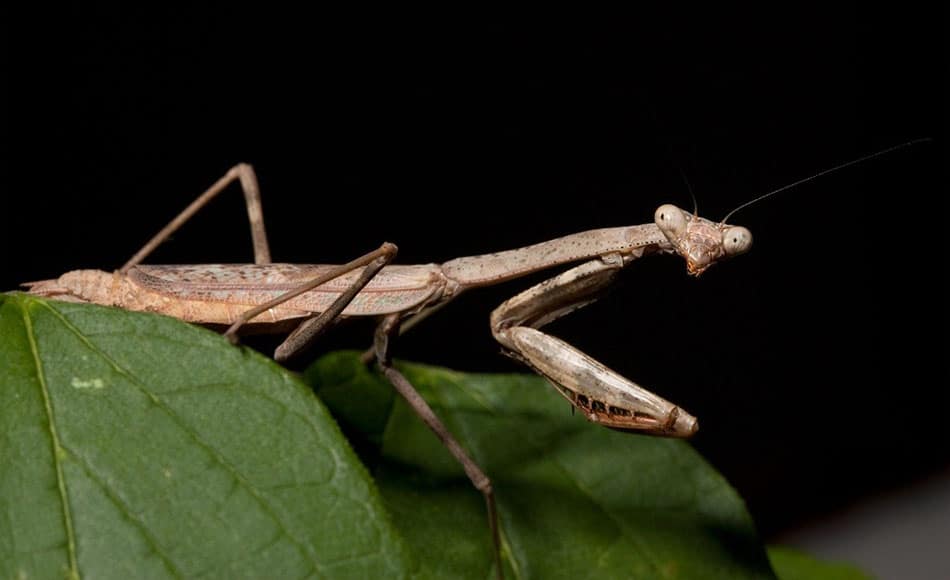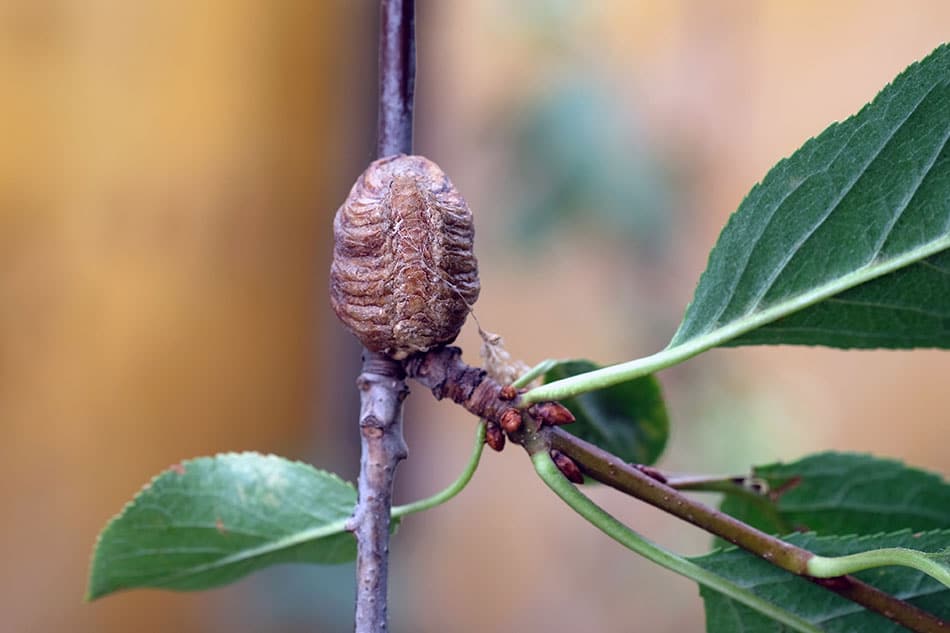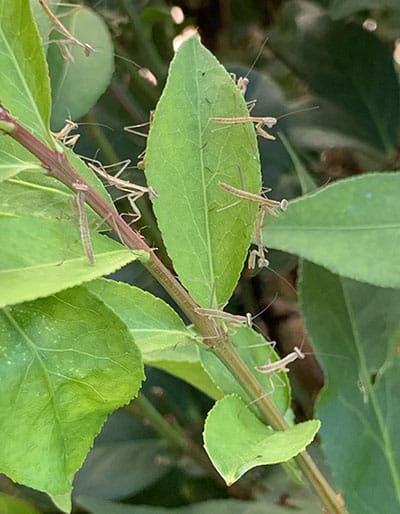The praying mantis is a beneficial insect that preys on insect pests in the garden, including the Spotted Lanternfly. Learn how to attract them to your yard, which ones to buy (as an egg case), when and where they appear, and what they eat.
If your garden is healthy and bursting with foliage and flowers, you can congratulate yourself on your horticultural skills. But you’ll also want to tip your hat to the beneficial insect predators that roam your garden killing and eating insect pests, often without you ever seeing them at work.
Who are these little heroes? There are many, but today we’re going to talk about just one: the praying mantis.

What’s That Weird-Looking Thing?
Don’t worry – it’s just a praying mantis and no, it didn’t come from outer space. Praying mantises (or mantids) are iconic for their long neck (actually their thorax) and bulging eyes, as well as their folded forearms that give them their common name. That many of them are bright green only adds to their alien appearance.
But don’t be afraid of these strange visitors. Instead, welcome them to your garden!
Why? Because they’ll eat up every insect pest you don’t want around and they won’t ask for anything in return, except maybe some moisture and a few extra leaves and stems left on your plants for their egg cases.
What Does a Praying Mantis Eat?
In a word, plenty! The mantis’s iconic forearms have evolved for split-second grabbing of any nearby prey, and a mantis will grab only moving or live meals.
The Carolina mantis will eat:
- mosquitoes,
- moths,
- wasps,
- flies,
- aphids,
- caterpillars,
- mites,
- cockroaches, and
- “bugs” in general.
Those are reasons enough to like praying mantises, but what might be the best thing about them is that they eat the larvae of the invasive Spotted Lantern Fly. As you probably know by now, the Spotted Lantern Fly (SLF) is an invasive insect pest that is spreading through New Jersey and Pennsylvania, and beyond.
Keep in mind, however, that mantises are indiscriminate predators; they’ll eat anything they can catch, including butterflies, bumblebees, and other beneficial insects.
One thing to remember about praying mantises is that they, like other beneficial predators, will only hang around even the most spectacular of gardens if there are things to eat.
If you release mantises into your garden and they disappear, they may be hiding in foliage OR they may have moved next door where food supplies are more plentiful. This doesn’t mean they won’t move back but if they do go exploring beyond your property, take the philosophical approach: If “your” mantises step out, they’re still eating nearby insect pests and those pests will never make it over to your plants.
Types of Praying Mantis
Before you add a praying mantis to your garden, make sure it’s the right one. Several species of praying mantises are marketed and sold as beneficial garden predators, but only buy our native species, Stagmomantis carolina, the Carolina mantis.
Why? Because the other, imported species of praying mantises aren’t reliable predators of the garden pests we want to eradicate.
The European mantis (Mantis religiosa) and the Asian mantis (Tenodera sinensis) were accidentally introduced in the U.S. in the late nineteenth century through plant nurseries, and have spread throughout the north- and southeast states. The Asian mantis is over four inches long, which is twice the size of our native species, and has been documented preying on the precious wildlife we want and need, such as songbirds and hummingbirds, as well as lizards and small snakes!
You can read about the dangerous side of predatory mantises on New Jersey’s Audubon chapter website.
What To Look For
They’re pretty easy to identify from their weird head and folded forearms, but what you may not know is that mantises use natural camouflage to lie in wait for their prey. Brown and green are common mantis colors and also the most common garden colors, so it can take a little effort to spot a mantis when it’s motionless on a twig or leaf.
Another trait that praying mantises share with many other insects is their incremental growth. Mantises go through several growth stages, or “instars,” where they look like miniature versions of themselves. At each stage, the insect grows and develops, eventually resulting in a full-size, mature mantis by summer.
But before the tiny, newly hatched mantises appear in your garden, they have to hatch from their egg case. So if you want to watch their entire development, locate an egg case or “ootheca,” in late winter (deciduous plants make it easier to spot an egg case on a bare twig).

Praying Mantis Egg Cases
What do mantis egg cases look like? A Carolina mantis’s egg case is small (about 1.5” long), an inconspicuous light brown or grayish-brown, and usually found on stems, twigs, or branch crotches. What you’ll look for is a “zipper” like center stripe of lighter color. The larger European and Asian mantises have larger egg cases that are similarly inconspicuously colored but with a more spherical or cylindrical shape. These larger egg cases may surround a stem or twig like a campfire marshmallow on a stick.
Female mantises lay their eggs in late summer or early fall, at the end of their life cycle. The eggs are covered in a kind of white foam that the female secretes, which darkens and hardens to form a protective case that will survive the winter. It’s important to leave egg cases in place over the winter so that the mantis larvae can hatch in synch with the warming weather and get right to work in their surroundings. If you’re doing some winter pruning and find an egg case, don’t cut off the twig or stem with the case. If you leave it on the ground, ants or foraging mammals will find it and eat the larvae.
Buying a Praying Mantis Egg Case
You can find praying mantis egg cases for sale online and at garden supply stores or nurseries. Be sure that you’re buying Carolina mantis egg cases, not an introduced species.
To be successful, the egg cases must be “viable,” meaning that the larvae inside are alive. An egg case isn’t something that can sit on a shelf indefinitely so check the “packed on” date.
Many egg cases are sold in containers with some coir or coco fiber for both cushioning and moisture retention, and a perforated lid that allows for airflow. You’ll often find them stored in a refrigerator to mimic cold winter temperatures. Do not store egg cases in a freezer, as a freezer’s low temperature will kill the larvae.
Hatching Praying Mantids

Newly-emerged praying mantises on a burning bush
Insect larvae hatch in response to seasonal changes in sunlight and temperature. Praying mantises naturally emerge in late winter or early spring so you’ll want your egg case ready (by taking it out of the fridge) when the weather warms and your garden wakes up from its dormancy.
Once the egg case container is at room temperature tiny mantises will hatch, but you may have to wait longer than you think for them to emerge. Don’t get impatient; these little insects are on their own schedule! While you wait, make sure you’re providing what your egg case needs: some moisture, but no saturating wetness; warmth, but no direct sunlight or high heat. And if you’re hatching your egg case indoors, be sure to have some additional containers at the ready; they’re hungry when they emerge and will often see each other as a potential meal.
Once the mantises start hatching, you may be amazed by how many can come out of one tiny egg case. It can be up to 100 at once, so having a larger container or two means that your new friends will have enough room to spread out. When these insects emerge their soft exteriors immediately start to harden, and the little mantises need to move and stretch their segmented body, legs, and antennae as this occurs.
Mantises In Your Garden
Just as there are ways to make your garden attractive to beneficial predators like praying mantises, there are things you may be doing that will keep them away, or even harm them.
Easy things to avoid doing include:
- Spraying with traditional pesticides. These kill indiscriminately and will wipe out beneficial insect populations. Because native plants and insects can be out-competed by introduced or invasive species, you’ll want to use IPM or other less-toxic methods to keep unwanted insect populations low.
- Removing plant material without checking it out first. The praying mantis, like many other insects, uses leaves to lay its eggs. Before cutting back or removing leaves and stems, check them for egg cases. If you leave egg cases alone and let the larvae hatch, they will be able to grow to maturity and spread throughout your garden. It’s especially important to keep some twigs and branches through the winter, as the larvae in egg cases overwinter and hatch in spring.
And some things you should do in your garden are:
- Grow a range of flowering plants. Although mantises are not pollen or nectar eaters, they use flowering plants for egg laying and for finding insects to eat. Having flowering plants in your garden will provide habitat for beneficial pollinators as well as mantises, and will reward you with color, scent, and even fruit. Coneflowers, lavender, and raspberry canes are some examples of flowering habitat plants to consider adding to your garden. Mantises also use upright flowers and stems as vantage points to locate insect prey!
- Provide water or wet areas. Insects need some moisture to survive, so having a water source or a moist, shady area with groundcover will help your insects through the hot summer.
- Provide suitable habitat. Your garden doesn’t have to be wild or overgrown to attract beneficial predators. But keeping some areas less manicured provides habitat that encourages beneficial insects to stay around, eat pests, and lay their eggs for next year’s generation of natural pest control.
INTERESTED IN TRYING BENEFICIAL INSECTS?
We now offer beneficial insects as part of our Integrated Pest Management (IPM) services. Our goal is to provide you with a healthy, thriving garden without using toxic or dangerous pesticides that wipe out the pollinators we all rely on.
GET THE LATEST NEWS
Subscribe to the Organic Plant Care Newsletter and get timely and helpful tips and updates monthly.
There's no spam - we promise!





